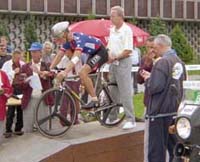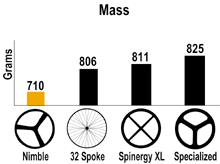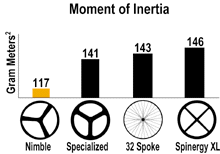| Top | Head-On Aero | Side-On Aero | Mass | Acceleration |
Investment |
The Nimble CROSSWIND™ is the result of two important investments: thousands of hours in design and development, and thousands of hours in comprehensive testing. Testing and design are so interdependent that they become almost indistinguishable. |
Team Designed, Team Tested |
 The Nimble CROSSWIND comes from a
diverse team combining cycling, science, design, manufacturing, marketing,
racing, and wrenching. Its test program continues to examine over 40
aspects of wheel performance. Tests range from mathematical and analytic modeling to
rigorous laboratory and field trials. Wheels have been raced in nearly every type of
performance road and multi-sport venue on every continent except Antarctica. These venues
include road stage racing, single day road events, sprint and endurance triathlons, short
and long distance duathlons, prologue and endurance time trials, track endurance, scratch
racing and sprint events. The Nimble CROSSWIND comes from a
diverse team combining cycling, science, design, manufacturing, marketing,
racing, and wrenching. Its test program continues to examine over 40
aspects of wheel performance. Tests range from mathematical and analytic modeling to
rigorous laboratory and field trials. Wheels have been raced in nearly every type of
performance road and multi-sport venue on every continent except Antarctica. These venues
include road stage racing, single day road events, sprint and endurance triathlons, short
and long distance duathlons, prologue and endurance time trials, track endurance, scratch
racing and sprint events. |
Demand First |
Learning
what is demanded of a wheel is the first step in learning the critical
elements of its performance. The more comprehensive your understanding, the more thorough
your design. What are the most critical areas of performance? Aerodynamics is
the single most significant contribution to road ride performance. A careful
treatment of aero drag accounts for both head-on calm condition measurements suitable to
track style events, and side-on crosswind measurements suitable to open road style events.
Additional performance areas include mass, because many competitive venues include
the challenge of gravity, and inertia or acceleration, because quickness and
handling can play a key role in competition. |
| Top | Head-On Aero | Side-On Aero | Mass | Acceleration |
What is It? |
Total head-on drag can be quantified in grams of resistance at a particular speed. This measure is a suitable indicator of aero performance for ride conditions protected from side winds. | ||
Design |
The most common aerodynamic designs concentrate primarily on this type of drag. Reduced spoke counts and deep section rims that reduce forward spoke turbulence are common strategies employed. The best solutions not only minimize total frontal profile, they also reduce the air disturbance created by the bodies in motion within that profile. At 14,290 mm2 of frontal area, the rim and body of the Nimble CROSSWIND hides behind a 19mm tire. The patented variable airfoil spokes and rim-to-spoke transition areas are the state-of-the-art in air-flow design. | ||
Benchmark Units |
Our testing showed 25 mph at 0 degrees yaw angle is a good benchmark point to compare head-on aero performance. This measure is comparable to the drag experienced by a front wheel during a 40K time-trial at 60 minute pace in a venue completely sheltered from wind. Our drag figures include a 19mm Continental Grand Prix tubular tire. | ||
25 mph at 0 degrees |
Nimble CROSSWIND | 88g |
|
| Specialized1 | 94g |
||
| Spinergy XL2 | 115g |
||
| 32 Spoke | 242g |
||
| Claims | At 88 grams at 25 mph, it has the lowest total head-on drag measured on a commercially available wheel. This measurement includes a tire, and may be reduced by substituting a narrow specialty track tire when appropriate. | ||
| 1The
most current marketing of this product as HED3 measures measures as 106g
due to production design changes 2The most current version of this product worsens drag to 128g due to changes in decoration, reinforcements and bearing placement. |
|||
| Top | Head-On Aero | Side-On Aero | Mass | Acceleration |
What is It? |
Total side-on drag can be quantified in grams of resistance at a particular speed at a characteristic angle of airflow. This measure is a suitable indicator of aero performance for ride conditions exposed open air crosswinds. | ||
Design |
In open road events, the total side-on drag is at least an equally important measure of aerodynamic performance. Strategies such as deep rims, that improve results in head-on tests, typically perform poorly in open air or side-on wind conditions. This is due to a higher side profile and a relatively poor distribution of shape and surface area within that profile. Simply put, broad rims catch and disturb more side air, and apply strong side loads at the rim where it creates the worst leverage for handling. Even at relatively low side angles of airflow, the increased drag on these deep section solutions typically overwhelms their aero benefits in head-on performance and increases their all-around aero skin drag losses and other performance barriers. Conventional shallow rim wire spoke wheels, while having relatively poor head-on drag results, have excellent side-on drag figures even with the added turbulence of their many spokes. This performance is primarily due to their low side area. | ||
Benchmark Units |
Outdoor, unsheltered, "open-air" venues are common. The aero demands of these venues vary by the race and the day; from the notorious crosswinds of the Ironman Hawaii to the quixotic gusts of a European stage-racing, from solo time-trialing to pack riding. Our testing captured total side-on drag profiles across a variety of venues and conditions. 22 mph, 21 degrees was selected as an exposure point yielding a drag measurement indicative of a typical total exposure weighted average from the crosswind segment of an open air venue. | ||
22 mph at 21 degrees |
32 Spoke | 320g |
|
| Nimble CROSSWIND | 383g |
||
| Spinergy XL | 507g |
||
| Specialized | 512g |
||
Claims |
The 383g total side-on drag capable design of the Nimble CROSSWIND
specifically addresses both head-on and side-on aerodynamics, minimizing both profiles and
managing air flow with its variable depth rim and variable airfoil shaped spokes. In
addition, the optimized side profile yields a noticeable improvement in ride comfort and
control. A rider can now more easily maintain an aero body position. The result is a new
standard in total aero performance. |
||
| Top | Head-On Aero | Side-On Aero | Mass | Acceleration |
What is It? |
Mass in grams of a complete front 700C tubular rim wheel. | ||
Design |
Every aspect of material and structure must be optimized to place high strength state-of-the-art materials where they help the most. The proprietary carbon/epoxy formulation of the Nimble CROSSWIND has one of the highest end-use strength-to-weight ratios of any material applied to commercial purposes. Our design benefits from extensive testing to optimize stiffness, and balance weight and strength. | ||
Benchmark Units |
Complete listings of other model variations and weights will be available soon. | ||
700C Front Tubular Mass |
Nimble CROSSWIND | 693g |
 |
| 32 Spoke | 806g |
||
| Spinergy XL | 811g |
||
| Specialized | 825g |
||
Claims |
The 710g front wheel redefines the aero category by over 100
grams. |
||
| Top | Head-On Aero | Side-On Aero | Mass | Acceleration |
What is It? |
The effort required to change your speed is best measured as total moment of inertia (MOI). Total translational MOI both addresses the effort required to spin a wheel up to speed (rotational MOI) and the effort required to accelerate it through space (lateral displacement). The units of measure for MOI are gram meters squared (gm2). MOI can be reliably measured to an accuracy that discerns between one brass and alloy spoke nipple. | ||
Design |
The all composite rim and spokes of the Nimble CROSSWIND are designed to minimize rotating mass moment. The variable depth rim further minimizes materials where it most greatly impacts rotating mass. | ||
Benchmark Units |
We list metric gram and meter based units to be consistent with ISO metrics. | ||
Total Moment of Inertia |
Nimble CROSSWIND | 117gm2 |
 |
| Specialized | 141gm2 |
||
| 32 Spoke | 143gm2 |
||
| Spinergy XL | 146gm2 |
||
Claims |
The 117gm2 net result not only sets a new standard for aero wheels, or even road wheels, its numbers and feel rival specialty sprint wheels that ignore aerodynamics. | ||